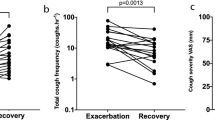Abstract
It is important to make a differential diagnosis of cough variant asthma in patients with chronic cough. To examine whether or not peak expiratory flow rate (PEFR) is useful for the differential diagnosis of cough variant asthma in such patients, diurnal variation rates of PEFR were calculated in 23 patients who presented with dry cough lasting four or more weeks and who showed no abnormalities on chest radiographs. None of the patients had wheezes, and pulmonary function testing at the time of visit to the hospital revealed no abnormalities. During the control period, the mean diurnal variation rate of PEFR in 23 patients was 16.3 ± 7.9%. Six, nine and eight patients had PEFR diurnal variations rates of <10% (Group 1), 10–19% (Group 2), and ≥ 20% (Group 3), respectively. At week 3 of treatment with bronchodilators, only Group 3 showed a significant decrease in PEFR diurnal variation rate from 25.7% to 10.1%. The cough score decreased significantly in Group 3 only. These patients had enhanced bronchial hyperresponsiveness and showed eosinophils in induced sputum, leading to the diagnosis of cough variant asthma (CVA). After making the diagnosis of CVA, an inhaled corticosteroid or a Th2 cytokine production inhibitor suplatast tosilate was administered to patients; consequently, they showed no recurrence of cough. PEFR monitoring allowed the detection of morning dip and was suggested to be potentially useful for the differential diagnosis of cough variant asthma in patients with chronic cough.


Similar content being viewed by others
References
RS Irwin LP Boulet MM Cloutier et al. (1998) ArticleTitleManaging cough as a defense mechanism and as a symptom. A consensus panel report of the American College of Chest Physicians Chest 114 IssueIDSuppl 133–181
WM Corrao SS Braman RS Irwin (1979) ArticleTitleChronic cough as the sole presenting manifestation of bronchial asthma N Engl J Med 300 633–637
ER McFadden SuffixJr (1975) ArticleTitleExertional dyspnea and cough as preludes to acute attacks of bronchial asthma N Engl J Med 292 555–559
MR Hetzel TJ Clark (1980) ArticleTitleComparison of normal and asthmatic circadian rhythms in peak expiratory flow rate Thorax 35 732–738
Global Strategy for Asthma Management and Prevention NHLBI/WHO Workshop Report. National Heart, Lung, and Blood Institutes (1995) Publication No. 95:3659
H Yamaya Y Basaki M Togawa M Kojima M Kiniwa N Matuura (1995) ArticleTitleDown-regulation of Th2 cell-mediated murine peritoneal eosinophilia by antiallergic agents Life Sci 56 1647–1654
Y Yanagihara M Kiniwa K Ikizawa T Shida N Matuura A Koda (1993) ArticleTitleSuppression of IgE production by IPD-1157T (suplatast tosilate), a new dimethylsulfonium agent: regulation of human IgE response Jpn J Pharmacol 61 31–39
A Koda Y Yanagihara N Matsuura (1991) ArticleTitleIPD-1151T: a prototype drag of IgE antibody synthesis modulation Agents Actions (Suppl) 34 369–378
J Tamaoki K Takeyama K Aoshiba J Nakata K Nishimura A Nagai (2003) ArticleTitleA Th2 cytokine inhibitor for airway inflammation in mild asthma J Allergy Clin Immunol 111 197–198
T Sano Y Nakamura H Yanagawa H Bando A Nii S Yoshida S Sano InstitutionalAuthorNamethe Higashishikoku Astma Research Group (2003) ArticleTitleAdd-on effects of suplatast tosilate in bronchial asthma patients treated with inhaled corticosteroids Lung 181 227–235
T Miyamoto (1994) ArticleTitleBronchial Asthma Severity Judgment Criteria-Reviewing Committee Report Jpn J Allergol 43 71–80
S Makino S Kobayashi T Miyamoto et al. (1982) ArticleTitleStandard methods of provocation tests for asthma and hypersensitivity pneumonitis Jpn J Allergol 31 1074
T Takishima T Sasaki K Takahashi H Sasaki T Nakamura (1972) ArticleTitleDirect-writing recorder of the flow-volume curve and its clinical application Chest 61 262–266
A Bhowmik TA Seemungal RJ Sapsford JL Devalia JA Wedzicha (1998) ArticleTitleComparison of spontaneous and induced sputum for investigation of airway inflammation in chronic obstructive pulmonary disease Thorax 53 953–956
PG Gibson J Dolovich J Denburg EH Ramsdale FE Hargreave (1989) ArticleTitleChronic cough: eosinophilic bronchitis without asthma Lancet 1 1346–1348
RS Irwin FJ Curley CL French (1990) ArticleTitleChronic cough. The spectrum and frequency of causes, key component of the diagnostic evaluation, and outcome of specific therapy Am Rev Respir Dis 141 640–647
M Fujimura Y Kamio T Hashimoto T Matsuda (1994) ArticleTitleCough receptor sensitivity and bronchial responsiveness in patients with only chronic nonproductive cough: in view of bronchodilator therapy J Asthma 31 463–472
JJ Quackenboss MD Lebowits M Krzyzanowski (1991) ArticleTitleThe normal range of diurnal changes in peak expiratory flow rates. Relationship to symptoms and respiratory disease Am Rev Respir Dis 143 323–330
T Todisco V Grassi CA Sorbini et al. (1980) ArticleTitleCircadian rhythms of respiratory functions in asthmatics Respiration 40 128–135
LR Bagg DT Hughes (1980) ArticleTitleDiurnal variation in peak expiratory flow in asthmatics Eur J Respir Dis 61 298–302
G Ryan KM Latimer J Dolovich FE Hargreave (1982) ArticleTitleBronchial responsiveness to histamine: relationship to diurnal variation of peak flow rate, improvement after bronchodilator, and airway calibre Thorax 37 423–429
K Tokuyama M Shigeta S Maeda K Takei M Hoshino A Morikawa (1998) ArticleTitleDiurnal variation of peak expiratory flow in children with cough variant asthma J Asthma 35 225–229
M Turner-Warwick (1997) ArticleTitleOn observing patterns of airflow obstruction in chronic asthma Br J Dis Chest 71 73–86
CK Connolly (1979) ArticleTitleDiurnal rhythms in airway obstruction Br J Dis Chest 73 357–366
Y Sano T Mitamoto S Mikino (1997) ArticleTitleAnti-inflammatory effect of suplatast tosilate on mild asthma Chest 112 862–863
J Tamaoki M Kondo N Sakai et al. (2000) ArticleTitleEffect of suplatast tosilate, a Th2 cytokine inhibitor, on steroid-dependent asthma: a double-blind randomized study Lancet 356 273–278
T Shioya M Satake M Sano et al. (2002) ArticleTitleEffect of suplatast tosilate, a Th2 cytokine inhibitor, on cough variant asthma Eur J Clin Pharmacol 58 171–176
Author information
Authors and Affiliations
Corresponding author
Rights and permissions
About this article
Cite this article
Sano, T., Ueda, H. & Bando, H. A Preliminary Study of PEFR Monitoring in Patients with Chronic Cough. Lung 182, 285–295 (2004). https://doi.org/10.1007/s00408-004-2510-7
Accepted:
Issue Date:
DOI: https://doi.org/10.1007/s00408-004-2510-7




